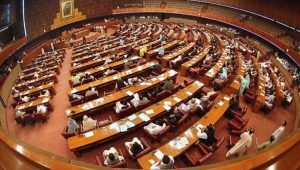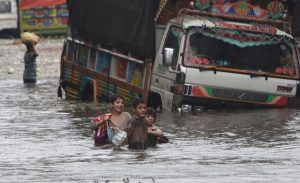
Least to Blame, Yet Among the Most Vulnerable — Climate Change Threatens Pakistan’s Future with Heatwaves, Floods, and Economic Devastation

CLIMATE CHANGE IN PAKISTAN Facts & Figures What is Climate Change? · Climate change refers to long-term changes in the average weather patterns on Earth. The primary cause of recent climate change is the increase in greenhouse gases, such as carbon dioxide and methane, in the atmosphere resulting from the combustion of fossil fuels. These gases trap heat from the sun, causing the Earth’s temperature to rise—a process commonly referred to as global warming. · For countries like Pakistan, climate change is becoming increasingly harsh. Although Pakistan contributes only about 0.88% of the world’s greenhouse gas emissions, it is the 5th most vulnerable country to climate change. · For Pakistan, climate change matters as it has led to: o Rising Temperatures: Pakistan’s average temperature is increasing, leading to hotter days and more intense heatwaves. o Extreme Weather Events: Changes in climate result in more severe and unpredictable weather events in Pakistan, such as storms, floods, and droughts. o Melting Ice and Rising Sea Levels: Higher temperatures cause polar ice to melt, leading to rising sea levels and coastal flooding. o Disruption of Ecosystems: Many plants and animals are struggling to survive as their natural habitats change or disappear.
Impacts of Climate Change on Pakistan (stats) · Climate change is not only a threat to the environment, but also to the economic security of Pakistan. Without proper action, climate-induced disasters in Pakistan would become more intense. · Pakistan has experienced significant temperature increases over the past few decades. The average annual temperature has increased by about 0.5°C since the 1960s. By 2050, the average temperature is projected to rise by an additional 1.3°C to 1.5°C. · Over the past years, the intensity of climate-induced disasters in Pakistan has significantly increased. With over 1700 deaths and 12000 injuries, world bank reported the economic losses and reconstruction in flood-hit areas of Pakistan in 2022 to be over USD 40 billion · An increase in the number of people affected by flooding is projected, with a likely increase of around 5 million people exposed to extreme river floods by 2035–2044, and a potential increase of around 1 million annually exposed to coastal flooding by 2070– 2100.
Rainfall patterns are becoming increasingly erratic. While annual precipitation is expected to decrease in some regions, others may see more intense and unpredictable rainfall events. This variability is already contributing to extreme weather events like floods and droughts. · The World Bank estimated that the combined risks of extreme climate-related events, environmental degradation, and air pollution are projected to reduce Pakistan’s GDP by at least 18 to 20% by 2050. This will stall progress on economic development and poverty reduction.




